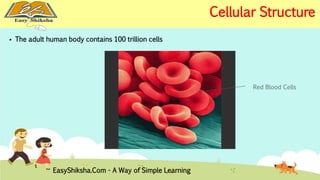
Cellular System
- 1. Red Blood Cells The adult human body contains 100 trillion cells Cellular Structure EasyShiksha.Com - A Way of Simple Learning
- 2. What tool do we use to observe cells? EasyShiksha.Com - A Way of Simple Learning Observing a Cell
- 3. Microscope History Robert Hooke – English scientist; first to use the term “cell”; came from monk’s quarters Anton von Leeuwenhook - Dutch scientist first to observe and describe microorganisms EasyShiksha.Com - A Way of Simple Learning
- 4. Microscope Characteristics Magnification - making image larger than it really is Resolution - measure of clarity of an image Good = clear crisp image Poor = fuzzy image Micrograph – the image produced by a microscope EasyShiksha.Com - A Way of Simple Learning
- 5. Types of Microscopes Compound Light – uses two lenses; magnify up to 1,000 times, can view live specimens Electron Microscope – magnify up to 200,000 times -Used to look at cell structure or cell surfaces Scanning Tunneling Microscope – able to view atoms, can view live specimens EasyShiksha.Com - A Way of Simple Learning
- 6. EasyShiksha.Com - A Way of Simple Learning
- 7. Transmission Electron Microscope EasyShiksha.Com - A Way of Simple Learning
- 8. Smallest unit of life is the cell Cell Theory - developed by 3 German scientists: Schleiden, Schwenn, and Virchow EasyShiksha.Com - A Way of Simple Learning Cell Features
- 9. 3 parts of Cell Theory 1) all living things are made of one or more cells 2) cells are the basic unit of structure and function in organisms 3) all cells arise from existing cells EasyShiksha.Com - A Way of Simple Learning
- 10. Why are cells so small? Smaller = more efficient Small cells can exchange substances more readily EasyShiksha.Com - A Way of Simple Learning
- 11. Surface area and cell size Cell size is limited by the cell surface area Cell size increases = surface-area-to-volume ratio decreases When the volume of a cell increases, the surface area increase at a slower rate. Surface area is important to cell growth because the cell may become too big to take in enough food and to remove enough wastes. EasyShiksha.Com - A Way of Simple Learning
- 12. Two types of cells Prokaryotic & Eukaryotic Only eukaryotic cells have membrane-bound organelles Orgnaelles: structures that perform a specific function All cells have the following: Cell membrane, cytoplasm, cytoskeleton, ribosomes EasyShiksha.Com - A Way of Simple Learning
- 13. Chromosomes Cilia or Flagella Cell Membrane Ribosomeso Cytoplasm Cytoskeleton Cell Wall (NO NUCLEUS) Centrioles Endoplasmic Reticulum Golgi Complex Lysosomes Mitochondria Nucleus Peroxisomes EasyShiksha.Com - A Way of Simple Learning Comparing Cells
- 14. small single celled organism that lacks a nucleus and other internal compartments (lacks membrane-bound organelles) DNA is single, circular molecule Prokaryotes (bacterium) cell wall determines shape due to no internal skeleton many use flagella for locomotion EasyShiksha.Com - A Way of Simple Learning
- 15. Examples of Prokaryotic Cells Blue Green Bacterium E.Coli Bacterium Salmonella Bacterium EasyShiksha.Com - A Way of Simple Learning
- 16. (plants, animals, fungi, protists) Cell Membrane * encloses the contents of a cell * allows materials to enter and leave cell * selective permeability – allows certain substances to pass thru cell membrane EasyShiksha.Com - A Way of Simple Learning Eukaryotes
- 17. Cell Membrane as a Barrier phospholipid – phosphate group and two fatty acids Forms a lipid bilayer within a cell membrane phosphate group – polar heads that interacts with H20 fatty acids – non-polar tails lipid bilayer non-polar tails form interior of membrane polar head form exterior membrane proteins proteins and enzymes embedded in membrane polar and non-polar amino acids, which allow them to remain in membrane different roles played: cell-surface marker receptor proteins transport proteins EasyShiksha.Com - A Way of Simple Learning
- 18. Diagram of Lipid Bilayer EasyShiksha.Com - A Way of Simple Learning
- 19. Membrane Proteins Lipid Bilayer Outside of cell Inside of cell EasyShiksha.Com - A Way of Simple Learning
- 20. Diagram of Eukaryotic Cell EasyShiksha.Com - A Way of Simple Learning
- 21. Cell Organelles: Structure that performs a specific function Found only in Eukaryotes A. The Nucleus controls most functions of the cell nuclear membrane/ nuclear envelope: double membrane around the nucleus that has nuclear pores heredity info coded as DNA in nucleus as strands called chromosomes Identifies cell as Eukaryotic EasyShiksha.Com - A Way of Simple Learning
- 22. Ribosome and Endoplasmic Reticulum (ER) B. ribosomes – where proteins are made -attached to ER and others are free floating C. ER – move proteins and other substances thru the cell, maintains homeostasis rough ER – ribosomes attached smooth ER – lack ribosomes; make lipids and breakdown toxic substances EasyShiksha.Com - A Way of Simple Learning
- 23. D. Golgi Apparatus – flatten, Packing and Distributing Proteins membrane-bound sacs that serve as packaging and distributing center of cell(warehouse of cell) Produces vesicles filled with proteins E. Lysosomes – contain cell’s digestive enzymes (Fig. 3.15 in book) EasyShiksha.Com - A Way of Simple Learning
- 24. harvests energy from organic compounds to make ATP outer and inner membrane have specific mitochondrial DNA; different from nuclear DNA EasyShiksha.Com - A Way of Simple Learning Mitochondria
- 25. Other Organelles Cilia: short, hairlike structures that protrude from the surface of a cell Packed in tight rows Help in movement Flagella: used for movement EasyShiksha.Com - A Way of Simple Learning
- 26. Unique Features of Plant Cells 1. Cell Wall – support and maintain cell shape (cellulose) 2. Chloroplasts – use light energy to make carbs from CO2 and H20, photosynthesis -have own DNA 3. Central Vacuole – stores water & nutrients; maintains rigidity of plant. EasyShiksha.Com - A Way of Simple Learning
- 27. Anatomy of Animal Cell EasyShiksha.Com - A Way of Simple Learning
- 28. EasyShiksha.Com - A Way of Simple Learning
